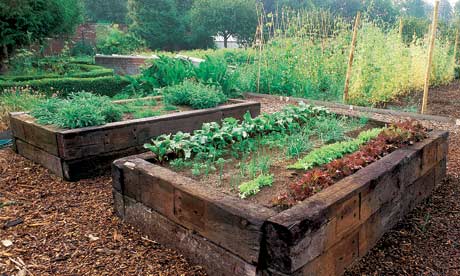RAISED BEDS, or NO GOPHERS NEED APPLY!

What? You think you can keep me out with a RAISED BED GARDEN?
errr What is a Raised Bed Garden?Well, Gordon Gopher, a raised bed garden is a garden built on top of your native soil, sometimes incorporating more native soil, but mostly you add amendments. Mushroom factories have to give away huge quantities of their special soil every 3 weeks, so call owner of every farm found as every name on every box at the super market, Drive out there with a truck. Get a solid half ton of soil for free.

If you have gophers, the builder has an option to put some wire screen under the bed on top of the native soil, to keep Gordon and his relatives OUT! So yes, raised bed gardens can be contained! Varmints can also be locked out when we humans build a wood or stone structure to keep the bed intact & keep some unwanted nibbly visitors OUT. Raised beds can be built with dry stacked cement found for free in alleys, or with old fencing planks with stakes to hold them vertical. Something must contain' the soil. Edging shapes can be free form, see GARDEN LAYOUT... Anyway you stack it, soil and amendments are piled inches or several feet high. But the higher you go, the more you need structurally sound edging and that costs money. But once you get a raised bed, even a l0" one, you can plant anything from herbs and vegetables to perennials and shrubs and even trees. While you're at it, catch this author/ country gentleman GENE GERUE at his own blog. Get his books.
Advantages of a Raised Bed Garden
Aside from avoiding the issue of gardening in poor soil, raised bed gardens offer several advantages:
* Raised beds warm more quickly in spring, allowing you to work the soil and plant earlier.
* Raised beds drain better.
* The soil in raised beds doesn't get compacted, because they are constructed with accessibility in mind.
* It's easy to tailor the soil for your raised bed to the plants you plan to grow there.
* After the initial construction process, raised beds require less maintenance than conventional garden beds.
* Voles, Gophers, Moles can't get in if you build the thing right.How to Make a Raised Bed Garden
Contained raised beds are the most popular type of raised beds, and they're great for vegetable and herb gardens, as well as flower gardens. Fruits, such as strawberries, grapes, blueberries, and raspberries, also do very well in a contained raised bed.
You can choose from a variety of materials to construct your raised bed. Wood is a very popular choice, because it is easy to work with and it is inexpensive. Concrete blocks, natural stone, or brick are also nice options, but there is definitely an added expense and labor to consider in using them. Some gardeners go the ultra-simple route, and simply place bales of hay or straw in whatever configuration they desire, then fill it with good soil and compost and plant it up. This solution will only give you a year of use, because the straw will decompose, but it's worth trying if you don't mind replacing the bales yearly, or if you're still developing a more permanent solution. Since most contained raised beds are constructed from wood, here are instructions for building your own wood raised bed garden.
Step One: Select your site. If you know that you'll be growing vegetables or herbs, or sun-loving flowers in your new garden, select a site that gets at least eight hours of sun per day. A flat, level area is important, and you should also make sure that the area has easy access to water sources as well as room for you to work.
Step Two: Determine the size and shape of your garden. Make sure that you can access all parts of the garden without stepping into the bed. One of the main advantages of a raised bed is that the soil doesn't get compacted the way it might in a conventional bed because they are planned for accessibility. It is a good idea to keep the garden to around four feet wide, because this way you can access the middle of the bed from either side. If you're placing your bed against a wall or fence, it should be no more than three feet wide. Any length you like will work, as long as you keep the width in control. In terms of depth, six inches is a good start, and many vegetables grow well in a bed that is six inches deep. As with many things, though, if you can do more, more is better! Ten to twelve inches would be ideal. If you have decent subsoil (not too clayey or rocky) you can simply loosen the soil with a garden fork and build a six to eight inch deep bed. If your soil is bad, or you are planning to grow crops like carrots or parsnips that need a deeper soil, your bed should be at least ten inches deep.
Step Three: Prep Your Site. Once you know the size and shape of your bed, you can get to work prepping the site. How much prep you will have to do is determined by the depth of the bed you're planning, as well as the plants you're planning to grow there. If you are planning a vegetable or herb garden, a six-inch deep bed is perfect. To save yourself some labor, you can use newspaper, landscape fabric, or cardboard to cover and smother it, then put your soil and amendments right on top. However, to ensure that your plant's roots have plenty of room to grow, it is a good idea to dig out the existing sod and loosen the soil with a shovel or garden fork to a depth of eight to twelve inches.
Step Four: Construct the Bed. Using rot-resistant lumber such as cedar or one of the newer composite lumbers, construct your bed. Two by six lumber is perfect, as it is easy to work with and will give you six inches of depth. Cut your pieces to the desired size, then attach them together to make a simple frame. You can attach them in a variety of ways. You can make a simple butt joint at each corner, pre-drilling and then screwing the corners together with galvanized screws. You can use a small piece of wood in the corner,and attach each side to it.
Step Five: Level Your Frames. Using a level, make sure your frame is level in all directions. This is a necessary step because if your bed is not level, you will have a situation where water runs off of one part of the garden and sits in another. If part of your frame is high, just remove some of the soil beneath it until you have a level frame.
Step Six: Fill Your Garden. The whole point of a raised bed garden is that it gives you the opportunity to garden in perfect soil. Take this opportunity to fill your bed with a good mixture of quality topsoil, compost, and rotted manure. Once they're filled and raked level, you're ready to plant or sow seeds.

THE NATURAL CONTOURS OF DESIGN MAKE PRETTY BEDS!Happily, raised bed gardens require very little maintenance. Each spring or fall, it's a good idea to top dress with fresh compost and manure, or, if your bed only holds plants for part of the year, go ahead and dig the compost or manure into the top several inches of soil. As with any garden, mulching the top of the soil will help retain moisture and keep weeds down. Moisture retention is important, because raised beds tend to drain faster than conventional beds.
~^~^~^~^~^~^~^~^~^~^~^~^~^~^~^~^~^~^~
Our POSTER is ANITA SANDS HERNANDEZ, Los Angeles Writer, Futurist and Astrologer. Catch up with her websites TRUTHS GOV WILL HIDE & NEVER TELL YOU, also The FUTURE, WHAT'S COMIN' AT YA! & HOW TO SURVIVE the COMING GREAT DEPRESSION, and Secrets of Nature, HOLISTIC, AFFORDABLE HEALING. Also HOW TO LIVE on A NICKLE, The FRUGAL PAGE.* Anita is at astrology@earthlink.net ). Get a 35$ natal horoscope "my money/future life" reading now + copy horoscope as a Gif file graphic!
<=== BACK TO TRACKING THE ECONOMY, an INDEX PAGE
<===BACK TO MONEY SECRETS ONLY THE EXPERTS KNOW
<=== BACK TO SECRETS THE GOV DOES NOT WANT YOU TO KNOW
<=== SHOW ME THE FIX INDEX PAGE.
<== SHOW ME THE HAPPY R)EVOLUTION PAGE
<=== BACK TO "GUERILLA CAPITALISM" -- THE SOLUTION!
<=== BACK TO REAL CAUSES OF THE MELTDOWN -- a WEBPAGE
<------BACK TO THE VULTURE SANDWICH, WORLD STARVATION INDEX PAGE
<------ BACK TO HOW TO STEAL A CORPORATION FROM THE STOCKHOLDERS
<=== GUERILLA CAPITALISM FOR YOU AND ME!
<----- BACK TO THE IMPORT EXPORT TRAINING SEMINAR
<----- BACK TO THE LEGACY TRADE SEMINAR
<===BACK TO THE SURVIVE ANY DISASTER WEBPAGE
<=== BACK TO BEST FOOD GARDEN BOOK EVER "CHICO's GARDEN" BUY USED FOR A BUCK ONLINE
<===BACK TO WHAT'S IN THE FUTURE FOR NORTH AMERICA?
<===BACK TO THE COUCH POTATO ACTIVIST'S METHOD FOR EVOLVING WASHINGTON D.C
<=== BACK TO THE EASY, BREEZY, NO WORK AT ALL GARDEN ARCHIVE for Suburban farmers
<== BACK TO ANITA SANDS WEBSITE